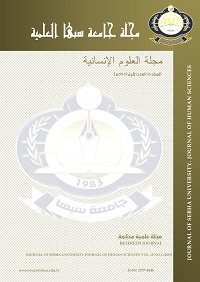Perception of body image and control center patterns for girls who are late in marriage
Main Article Content
Abstract
The current study aimed to identify the nature of the relationship between perception of body image (positive-negative) and patterns of control center (internal - and external) in marriage arrears, and to know the differences between the perception of body image and pattern of control center according to some demographic variables, namely, Gregorian arrangement) in light of theories of causal attribution. The sample of the study consisted of (14) single women, the personal selection was made from the cities of Al-Bayda, Al-Qobba, Derna, who met the conditions of age (over 24 to 47) years, and the civil status (single). The body image scale was applied to the numbers of Zainab Choucair (2002), the control center scale was the number of Roter and Arabization (Aladdin Kafafi, 1982) The psychometric properties of the scales were confirmed. After analyzing the data using statistical methods, including the Pearson correlation coefficient and the test (T), and the descriptive approach. The study reached the following main results:
There is a negative correlation between the perception of body image and the pattern of the center of control in the single category as a whole.
There are statistically significant differences between the single women in the pattern of the center of the internal control and the pattern of the center of the external control in favor of women with the pattern of the center of the external control.
- The absence of differences between those with the center of the external control pattern and those with the pattern of the center of the internal control in perceiving the image of the body (positive).
Downloads
Article Details
Journal of Humanities Policy on Intellectual Property and Plagiarism
1. Commitment to Intellectual Property and Ethics
The Journal of Humanities (JOHS) is fully committed to respecting intellectual property rights and aims to protect the originality and authentic work of authors who submit their manuscripts for publication. The journal takes a firm stand against articles that contain any form of plagiarism and emphasizes the need for all researchers to adhere to the highest ethical standards in scientific research.
2. Anti-Plagiarism Policy
The journal considers plagiarism a serious violation of academic ethics. Therefore, authors must ensure that their work is original and not plagiarized, and that any use of external sources is properly cited and documented according to correct academic standards.
-
Actions Taken: In the event that any plagiarism or academic theft is discovered in a submitted article, the editorial board will contact the author to request a formal explanation within a maximum period of two weeks from the date of notification.
-
Investigation and Decision: After receiving the explanation, the article will be referred to the journal's specialized committees, which will investigate the matter and take the necessary measures, which may include the permanent rejection of the article and the imposition of disciplinary actions.
3. Publication License and Author Rights
The journal adopts the Creative Commons license type Attribution-NonCommercial-NoDerivs 4.0 International (CC BY-NC-ND 4.0), which allows for the following:
-
Attribution: Users are entitled to cite the content published in the journal and use it in their work, provided that the original source and author are clearly credited.
-
Non-Commercial: The published content may not be used for any commercial purpose.
-
NoDerivs: It is not permitted to make any modifications, distortions, or to build derivative works from the published content.
Under this license, authors are required to complete an exclusive license agreement for the journal. Authors retain the rights to their research data and may reuse and share their work for scientific purposes with proper citation.




